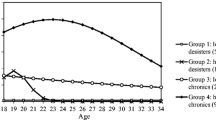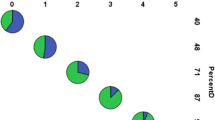Abstract
Fifty-five emotionally and socially deviant but normally intelligent adolescents who had spent 2–7 years in a children's and apprentice home in Israel were followed up 5–9 years after they had left the institution. Their postresidential social and vocational careers were evaluated by means of personal interviews, home visits, and reports from employers, and it was found that good adjustment was substantially related to family background variables (having lived with biological parents prior to residential placement, mutual positive relationship between parent and child, being first born) as well as to satisfactory behavior and performance in peer group, school, and workshop during residence. Level of intelligence, unrelated to overall adjustment, correlated positively with vocational status and income at followup. On the other hand, length of stay in the apprentice home had no impact on postresidential adaptation to work and society. Fewer than 10% of exinmates expressed retrospectively a negative attitude toward their stay in the institution. The importance of paying more attention to the eventual long-term and enduring impact of family relationship on the residential and postresidential behavior of adolescents is discussed, suggesting a shift of emphasis in evaluating factors involved in institutional treatment. Findings also indicate that later social and vocational success may be fairly predicted from observation of behavior during the stay in the institution.
Similar content being viewed by others
References
American Association on Mental Deficiency (AAMD) (1972). International Research Seminar on Vocational Rehabilitation of the Mentally Retarded, Special Publication Series No. 1, Washington, D.C.
Beres, D., and Obers, S. J. (1950). Effects of extreme deprivation in infancy on psychic structure in adolescence.Psychoanal. Stud. Child 5: 212–235.
Bodman, F., MacKinlay, M., and Sykes, K. (1950). The social adaptation of institutionalized children.Lancet 358: 173–176.
Dinnage, R., and Kellmer Pringle, M. L. (1967).Residential Child Care: Facts and Fallacies, Longmans, London.
Ferguson, T. (1966).Children in Care — and After. Oxford University Press, Oxford.
Garber, B. (1972).Follow up Study of Hospitalized Adolescents, Bruner-Mazel, New York.
Gossett, J. T., Lewis, S. B., Lewis, J. M., and Phillips, V. A. (1973). Follow up of adolescents treated in a psychiatric hospital.Am. J. Orthopsychiat. 43(4): 602–610.
Haggerty, A. D. (1953). The intellectual functioning of a postinstitutional group.J. Genet. Psychol. 83: 303–306.
Jackson, S., and Butler, A. (1963). Prediction of successful community placement of institutionalized retardates.Am. J. Ment. Defic. 68: 211–217.
Jaffe, E. D. (1969).Children Away from Home, P. Beerwald School of Social Work, Hebrew University, Jerusalem.
Maas, H. S. (1963). The young adult adjustment of twenty wartime residential nursery children.Child Welfare 42: 57–72.
Masterson, J. F. (1958). Prognosis in adolescent disorder.Am. J. Psychiat. 114: 1097–1103.
Masterson, J. F. (1972).Treatment of the Borderline Adolescent: A Developmental Approach, Wiley, New York.
Matsushima, J. (1965). Some aspects of defining “success” in residential treatment.Child Welfare 44(5): 272–277.
Song, A. Y., and Song, R. H. (1969). Prediction of job efficiency of institutionalized retardees in the community.Am. J. Ment. Defic. 73(4): 567–571.
Weeks, H. A. (1958).Youthful Offenders at Highfields, University of Michigan Press, Ann Arbor.
Walther, R. H. (1970).The Measurement of Work Relevant Attitudes, Final Report, Contract No. 41-7-004-09. Department of Labor, Washington, D.C.
Whittaker, J. K. (1972).Children Away from Home: A Sourcebook of Residential Treatment, Aldine-Atherton, Chicago.
World Health Organization (1963). The Care of Well Children in Day Care Centers and Institutions, WHO Technical Report No. 256, Geneva.
Author information
Authors and Affiliations
Additional information
The empirical study reported in this article was supported by a grant from the Australian Women's International Zionist Organisation (WIZO), through the initiative of Mrs. Martha Jacobson, Melbourne, chairman of the board of directors.
Received his Ph.D. in Psychology and Special Education from the University of Zurich, Switzerland, in 1954. Main research interests are normal and abnormal child development, high-risk infants, adolescence, and handicapped children.
Main research interest is institutional care.
Rights and permissions
About this article
Cite this article
Kohen-Raz, R., Jonas, B. A post-residential-treatment follow-up of socially and emotionally deviant adolescents in Israel. J Youth Adolescence 5, 235–250 (1976). https://doi.org/10.1007/BF01577621
Received:
Issue Date:
DOI: https://doi.org/10.1007/BF01577621




